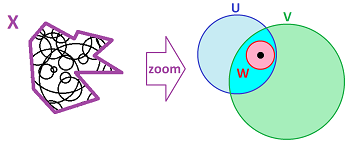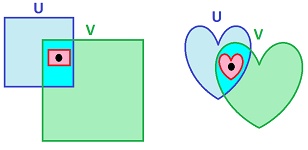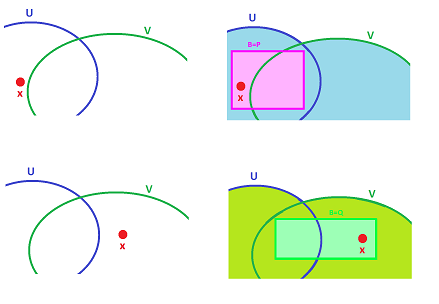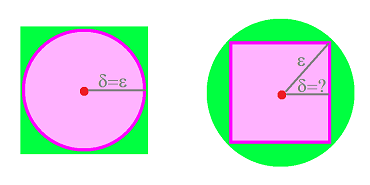This site is being phased out.
Bases of neighborhoods
Bases of neighborhoods
Let's recall our main definition.
Definition. Suppose $X$ is any set. Any collection $\gamma$ of subsets of $X$ satisfying properties:
- (B1) Covering: $\cup \gamma = X$;
- (B2) Refining: for any neighborhoods $U, V\in \gamma$ and any point $x\in U\cap V$ in their intersection, there is a neighborhood $W\in \gamma$ of $x$ such that $W \subset U \cap V$;
is called a basis of neighborhoods in $X$. The elements of $\gamma$ are called neighborhoods and if $x \in W \in \gamma$, we say that $W$ is a neighborhood of $x$. We commonly use $W_x$ to emphasize that.
The purpose of this definition is to be able to discuss continuity of functions in the most general setting. Indeed, $X$ doesn't have to have either algebraic (such a vector space) or geometric structure (such as a metric space).
In the $1$-dimensional Euclidean case, our neighborhoods $\gamma$ have been simply open intervals which makes the refining condition of $\gamma$ is especially simple: $$(a,b),(c,d) \in \gamma, a<c<b<d \Rightarrow (a,b)\cap (c,d) =(c,b)\in \gamma.$$
We can modify this $\gamma$ by choosing open intervals with only rational end-points, or irrational, etc. However, closed intervals (of non-zero length) won't work as $$[a,b],[b,c] \in \gamma, a<b<c \Rightarrow [a,b]\cap [b,c] =\{b\}\not\in \gamma.$$
Another basis in ${\bf R}$ is the rays $R(s)= \{u \colon u > s \}$. Indeed: $$(a,\infty),(c,\infty) \in \gamma, a<c \Rightarrow (a,\infty)\cap (c,\infty) =(c,\infty)\in \gamma.$$
Exercise. Find more examples.
Exercise. As a preview of bases in more general but still $1$-dimensional spaces, prove that the collection of all open arcs is a basis of the circle.
The collection of all open balls in $X = {\bf R}^n$: $$\gamma_b = \{B(a, \delta): a \in {\bf R}^n, \delta > 0 \},$$ where $$B(p,d)= \{u \colon ||u-p|| < d \},$$ is a basis. We will call this the standard Euclidean basis.
What are other bases in ${\bf R}^n$?
An important example is the squares. The collection of all squares (with sides parallel to the axes) in ${\bf R}^2:$ $$\gamma_s = \{S((a,b),d) \colon (a,b) \in {\bf R}^2, d>0 \},$$ where $$S((a,b),d) = \{(x,y) \colon |x-a| < d, |y-b| < d \},$$ is a basis:
Exercise. Prove that. Hint: you have to be specific.
Exercise. Is the collection of all rectangles (with sides parallel to the axes) in ${\bf R}^2$ a basis? What is its analogue ("boxes") in ${\bf R}^n$?
The collection of closed balls $$\bar{B}(p,d)= \{u \colon ||u-p|| \leq d \}, d>0,$$ however is not a basis. It is easy to see if we observe that two closed balls may intersect by a single point which is not a closed ball. If we wanted to make this collection into a basis, we'd have to add all singletons, i.e., the one-point sets, to the collection. Since those are simply balls of diameter $0$, we end up with $$\gamma ' = \{B(a, \delta) \colon a \in {\bf R}^n, \delta \geq 0 \}.$$
Exercise. Prove that this is a basis.
The sets of
- rectangles,
- ellipses,
- stars, etc.
are also bases.
Open sets
Below we assume that $\gamma$ is fixed.
Now we define open sets as ones where every point has its own neighborhood:
Definition. A subset $W$ of $X$ is called open (with respect to a given basis of neighborhoods $\gamma$) if for any $x\in W$ there is a neighborhood $U\in \gamma$ of $x$ that lies entirely within $W$: $$x\in U \subset W.$$
For example all "open" balls and "open" squares are open.
Theorem. The intersection of two open sets is open.
We start with some analysis. We will need to write the definition three times for each of the three sets involved.
Suppose $U,V$ are open with respect to $\gamma$ and let $W=U \cap V$. Suppose $x\in W$ is given.
We want to show that $W$ is open, so we copy the definition and write it a more compact form: there is $N\in \gamma$ such that $$x\in N \subset W.$$ Now, since $W=U\cap V$, we have $$x\in N \subset U \text{ and } x\in N \subset V.$$ Since we have both $U$ and $V$ open, aren't these the exact definitions of openness for them? Yes, but applied separately, the definitions will produce two different $N$s! Fortunately, the refining condition (B2) will give us the desired -- smaller -- neighborhood of $x$.
We are now prepared to write the proof.
Proof. Given $x\in W=U\cap V$. Since both $U,V$ are open by assumption, we have:
- there is $P\in \gamma$ such that $x\in P \subset U$;
- there is $Q\in \gamma$ such that $x\in Q \subset V$.
In particular, we have $x\in P\cap Q$ and we can apply (B2) to this situation: there is $B\in \gamma$ with $$B\subset P \cap Q.$$ To continue $$B\subset P \cap Q \subset U\cap V=W.$$ So, we have shown that there is $B\in \gamma$ such that $$x\in B\subset W.$$ By definition, $W$ is open. $\blacksquare$
The construction is illustrated below:
The illustration is put after the proof to emphasize that it can't rely on -- or even refer to -- pictures.
What about the union? Even though it's about the union, let's try to recycle the proof for intersection. After all, we will have to use the definition of openness three times again.
Theorem. The union of two open sets is open.
Proof. We copy the proof from above and replace each $\cap$ with $\cup$. This is what we get:
"Suppose $U,V$ are open with respect to $\gamma$ and let $W=U \cup V$. Suppose $x\in W$ is given.
Given $x\in W=U\cup V$. Since both $U,V$ are open by assumption, we have:
- there is $P\in \gamma$ such that $x\in P \subset U$;
- there is $Q\in \gamma$ such that $x\in Q \subset V$.
[In particular, we have $x\in P\cup Q$ and we can apply (B2) to this situation: there is $B\in \gamma$ with $$B\subset P \cup Q.$$ To continue] $$B\subset P \cup Q \subset U\cup V=W.$$ So, we have shown that there is $B\in \gamma$ such that $$x\in B\subset W.$$ By definition, $W$ is open."
Turns out the part in brackets is unnecessary. Instead we just choose either $B=P$ or $B=Q$ depending on whether $P$ or $Q$ contains $x$.
$\blacksquare$
Why the proof is easy is illustrated below:
Theorem. The union of any collection of open sets is open.
Exercise. Prove this theorem (a) by following the proof of the last theorem, and (b) as a corollary.
Of course, a subset $A\subset X$ will be called closed if its complement $X \setminus A$ in $X$ is open.
Topology is generated by a basis
Let's summarize the results of the last section.
Theorem. Given a basis of neighborhoods $\gamma$, let $\tau$ be the set of all open sets with respect to $\gamma$. Then $\tau$ satisfies the following conditions:
- (T1) $\emptyset, X \in \tau$;
- (T2) if $\alpha \subset \tau$ then $\cup \alpha \in \tau$;
- (T3) if $U,V \in \tau$ then $U \cap V \in \tau$.
Exercise. Prove (T1).
Definition. Given a basis of neighborhoods $\gamma$, the collection $\tau$ of all sets open in $X$ with respect to $\gamma$ is called the topology of $X$ generated by $\gamma$.
Let's consider a few examples.
The smallest possible basis on $X$ is $$\gamma_a = \{X \}.$$
The largest possible is the set of all subsets of $X$ $$\gamma_d = \{A \subset X \} =2^X.$$
Theorem. All neighborhoods are open, i.e., $\gamma \subset \tau$.
Proof. Indeed:
- (T1) $\Rightarrow$ (B1);
- (T3) $\Rightarrow$ (B2). $\blacksquare$
A basis can be easily enlarged. Indeed if $U$ is open with respect to basis $\gamma$, then $\gamma \cup {U}$ is also a basis.
We can refine the basis of disks $B(x,\epsilon)$ with that of squares $S(x,\delta)$ and vice versa:
Lemma. For any $x\in {\bf R}^2$,
- for any $\epsilon >0$ there is $\delta>0$ such that $B(x,\delta)\subset S(x,\epsilon)$; and
- for any $\epsilon >0$ there is $\delta>0$ such that $S(x,\delta)\subset B(x,\epsilon)$.
Theorem. The topology $\tau_b$ generated by the disks $\gamma_b$ is the same as the topology $\tau_s$ generated by the squares $\gamma_s$.
Exercise. Prove the lemma and the theorem.
Another basis in ${\bf R}^2$ is $\gamma_q$, the quadrants: $$Q(p,q)= \{(x,y) \in {\bf R}^2 \colon x > p, y > q \}.$$
Exercise. Prove that.
Disks refine quadrants but not vice versa! This suggests the following:
Theorem. The topology $\tau_b$ generated by the disks $\gamma_b$ is NOT the same as the topology $\tau_q$ generated by the quadrants $\gamma_q$.
Exercise. Prove the theorem. Hint: you just need a single example of an open set.
When two bases generate the same topology they are called equivalent.
So, we have $5$ examples of bases in ${\bf R}^2$ and they generate the corresponding topologies:
- $\tau_a$, $X$ only $\to$ anti-discrete topology
- $\tau_d$, closed disks $\to$ discrete topology
- $\tau_b$, open disks $\to$ euclidean topology
- $\tau_s$, open squares $\to$ euclidean topology
- $\tau_q$, quadrants $\to$ "interval" topology
This is the hierarchy: $$\tau_a \subset \tau_q \subset \tau_b = \tau_s \subset \tau_d.$$
Exercise. Determine which the following collections are bases of neighborhoods:
- $\{[a, b) \subset {\bf R} : a < b\}$,
- $\{(n, n + 2) \subset {\bf R} : n \in {\bf Z}\}$,
- $\{[a, b] \subset {\bf R} : a < b\}$,
- $\{[a, b] \subset {\bf R} : a ≤ b\}$,
- $\{(−x, x) \subset {\bf R} : x \in {\bf R}\}$,
- $\{(−∞, q) \subset {\bf R} : q \in {\bf Q}\}$,
- $\{\{a\} × (b, c) \subset {\bf R}^2 :a, b, c \in {\bf R}\}$.
We may choose to enter Topology through the door we just found:
Definition. Any collection $\tau$ of subsets of $X$ is called a topology on $X$ if it satisfies the three conditions:
- (T1) $\emptyset, X \in \tau$;
- (T2) if $\alpha \subset \tau$ then $\cup \alpha \in \tau$;
- (T3) if $U,V \in \tau$ then $U \cap V \in \tau$.
The elements of $\tau$ are still called open sets.
The set paired up with a topology, $(X,\tau)$, is called a topological space.
Just as above, trying to come up with a smallest possible topology on $X$ we end up with $$\tau_a = \{ \emptyset, X \}.$$ It is called the anti-discrete topology.
The largest possible is the set of all subsets of $X$ $$\tau_d = \{ A \subset X\}=2^X.$$ It is called the discrete topology.
We restate the above theorem as the relation between bases and topologies.
Theorem. Given a basis $\gamma$, the collection $\tau$ of all sets open with respect to $\gamma$ is a topology.
The issue of "topological space vs its basis" is similar to that of "vector space vs its basis". Indeed, in either case
- the space is generated by its basis and
- there are many possible bases for the same space.
The dissimilarity is in the fact that there is no requirement for a basis of neighborhoods to be as small as possible. In fact, $\tau$ is generated by $\tau$.
Exercise. Suppose
- $X$ is a set,
- $\gamma$ is a basis of neighborhoods on $X$,
- $\tau$ is a topology on $X$ (unrelated to $\gamma$),
- $A$ is a subset of $X$.
Define:
- $\gamma '=\{N\cap A: N\in \gamma\}$,
- $\tau '=\{U\cap A: U\in \tau\}$.
Prove:
- (a) $\gamma '$ satisfies condition (B2),
- (b) $\tau '$ satisfies conditions (T2) and (T3).





